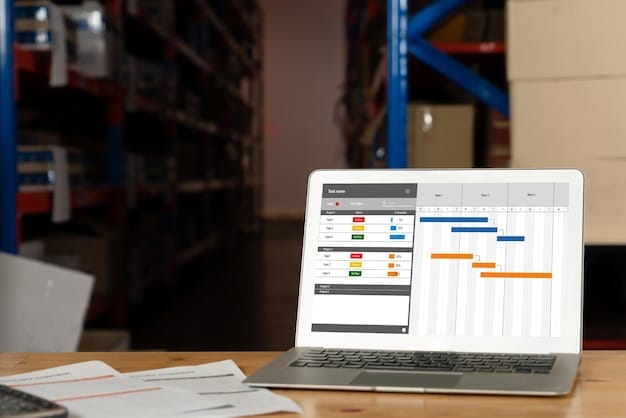Manage Your Inventory: Maximize Profits with Efficient Control Systems

Manage your inventory effectively by implementing efficient control systems to minimize waste and maximize profits, ensuring your small business thrives in a competitive market.
Are you a small business owner struggling with inventory management? Implementing efficient inventory control systems can be the key to minimizing waste and maximizing profits. Let’s explore how to manage your inventory effectively for business success.
Why Inventory Management Matters for Small Businesses
Inventory management is crucial for the survival and growth of small businesses. Proper control ensures you have enough stock to meet customer demand without tying up excessive capital in unsold goods. This balance is essential for maintaining healthy cash flow and profitability.
Effective inventory management is not just about knowing what you have in stock; it’s about optimizing your entire supply chain. From ordering to storage and sales, every step plays a role in minimizing waste and maximizing profits.
Reducing Waste Through Accurate Forecasting
One of the primary benefits of good inventory management is the reduction of waste. Accurate forecasting allows you to order the right amount of product, minimizing the risk of spoilage, obsolescence, or damage.
Improving Cash Flow
Efficient inventory control frees up cash that would otherwise be tied up in excess stock. This cash can then be reinvested in other areas of your business, such as marketing, product development, or hiring.
- ✅ Reduces storage costs and associated expenses.
- ✅ Minimizes the risk of stockouts, leading to lost sales.
- ✅ Improves customer satisfaction through timely order fulfillment.

In conclusion, effective inventory management is a cornerstone of small business success. By implementing efficient control systems, you can minimize waste, improve cash flow, and enhance customer satisfaction, ultimately driving profitability.
Key Components of an Efficient Inventory Control System
An efficient inventory control system comprises several key components that work together to ensure accurate tracking and management of your stock. These components include inventory tracking methods, demand forecasting techniques, and inventory analysis.
Understanding and implementing these components will help you optimize your inventory levels, reduce costs, and improve overall efficiency.
Inventory Tracking Methods
Inventory tracking methods are the foundation of any good system. Common methods include manual counting, barcode scanning, and RFID (Radio-Frequency Identification) tracking.
Demand Forecasting Techniques
Demand forecasting involves predicting future demand based on historical sales data, market trends, and seasonal factors. This allows you to anticipate customer needs and adjust your stock levels accordingly.
- ✅ Implement a robust inventory management software.
- ✅ Regularly audit your inventory to identify discrepancies.
- ✅ Train your staff on proper inventory management procedures.
Ultimately, a well-designed inventory control system will provide you with real-time visibility into your inventory levels, enabling you to make informed decisions and respond quickly to changing market conditions.
Choosing the Right Inventory Management Software
Selecting the right inventory management software is a critical decision for any small business. The software should align with your specific needs and budget while providing the functionality necessary to manage your inventory effectively.
There are numerous software options available, ranging from simple spreadsheet-based solutions to comprehensive enterprise resource planning (ERP) systems. Let’s explore some key considerations for choosing the right one.
Features to Look For
When evaluating inventory management software, look for features such as barcode scanning, real-time tracking, automated reordering, and integration with accounting and e-commerce platforms.
Cloud-Based vs. On-Premise Solutions
Consider whether a cloud-based or on-premise solution is best for your business. Cloud-based solutions offer greater flexibility and scalability, while on-premise solutions provide more control over your data.

Choosing the right inventory management software can significantly streamline your operations and improve your bottom line. Take the time to research and compare different options to find the best fit for your business.
Best Practices for Minimizing Waste in Inventory Management
Minimizing waste is a key objective of efficient inventory management. By implementing best practices, you can reduce spoilage, obsolescence, and excess stock, ultimately improving your profitability.
These practices include accurate demand forecasting, optimized storage conditions, and effective disposal strategies.
Accurate Demand Forecasting
Accurate demand forecasting is essential for avoiding overstocking and understocking. Use historical data, market trends, and seasonal factors to predict future demand and adjust your inventory levels accordingly.
Optimized Storage Conditions
Proper storage conditions can prevent spoilage and damage to your inventory. Implement measures to control temperature, humidity, and light exposure, especially for perishable goods.
- ✅ Implement a First-In, First-Out (FIFO) system.
- ✅ Conduct regular inventory audits to identify and remove obsolete items.
- ✅ Negotiate favorable return policies with suppliers.
By following these best practices, you can significantly reduce waste and improve the efficiency of your inventory management processes.
Strategies for Maximizing Profits Through Inventory Control
Efficient inventory control not only minimizes waste but also maximizes profits. By optimizing your inventory levels and improving your supply chain, you can increase sales, reduce costs, and enhance customer satisfaction.
Effective strategies include demand-based pricing, optimized reorder points, and improved supplier relationships.
Demand-Based Pricing
Adjust your pricing based on demand to maximize revenue. Increase prices for high-demand items and offer discounts for slow-moving stock to clear inventory.
Optimized Reorder Points
Set reorder points based on lead times and demand forecasts to ensure you never run out of stock. Use inventory management software to automate this process and avoid stockouts.
- ✅ Implement a Just-In-Time (JIT) inventory system.
- ✅ Negotiate volume discounts with suppliers.
- ✅ Use data analytics to identify profitable products.
By implementing these strategies, you can maximize profits through efficient inventory control and improved supply chain management.
The Future of Inventory Management: Trends and Technologies
The field of inventory management is constantly evolving, with new trends and technologies emerging to help businesses optimize their operations. Staying informed about these developments is essential for maintaining a competitive edge.
Emerging trends include the adoption of AI and machine learning, the use of drones for inventory tracking, and the growth of omnichannel retailing.
AI and Machine Learning
AI and machine learning are being used to improve demand forecasting, optimize inventory levels, and automate various inventory management tasks.
Drones for Inventory Tracking
Drones are increasingly being used to track inventory in warehouses and distribution centers, providing real-time visibility and reducing the need for manual counting.
- ✅ Embrace cloud-based inventory management solutions.
- ✅ Invest in data analytics to improve decision-making.
- ✅ Stay informed about industry best practices and emerging technologies.
In conclusion, the future of inventory management is bright, with numerous opportunities for businesses to improve their efficiency and profitability through the adoption of new technologies and strategies.
| Key Point | Brief Description |
|---|---|
| 📦 Accurate Forecasting | Predict demand to avoid over or understocking. |
| 📊 Inventory Software | Use software for real-time tracking and automation. |
| 💰 Profit Maximization | Optimize pricing and reorder points for max profit. |
| 🚀 Future Trends | Explore AI, drones, and omnichannel for efficiency. |
FAQ
▼
Inventory management helps small businesses control stock levels, reduce waste, and maximize profits by ensuring the right amount of product is available at the right time.
▼
Key components include inventory tracking methods, demand forecasting techniques, and regular inventory analysis to optimize stock levels and reduce costs effectively.
▼
Look for software with features like barcode scanning, real-time tracking, and integration with other platforms, and consider whether a cloud-based or on-premise solution suits your needs.
▼
Best practices include accurate demand forecasting, optimized storage conditions, implementing a FIFO system, and regularly auditing inventory to remove obsolete items and reduce spoilage.
▼
Maximize profits by implementing demand-based pricing, optimizing reorder points, improving supplier relationships, and using data analytics to identify profitable products and trends.
Conclusion
Effective inventory management is crucial for small businesses to minimize waste and maximize profits. By implementing efficient control systems, such as inventory tracking methods, demand forecasting, and the right software, businesses can optimize stock levels, reduce costs, and enhance customer satisfaction, paving the way for long-term success.





